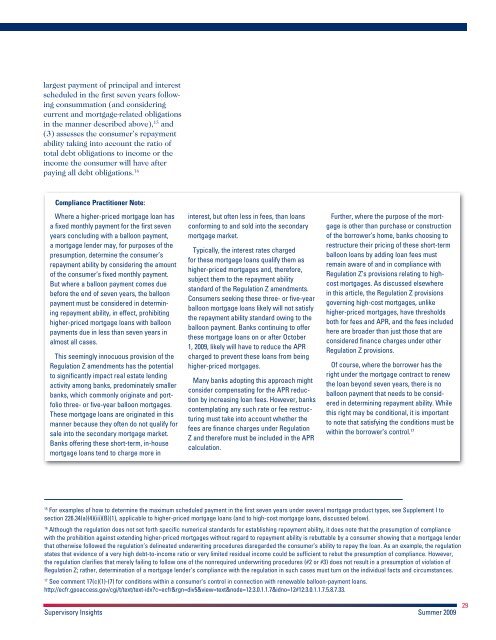FDIC Supervisory Insights Summer 2009
FDIC Supervisory Insights Summer 2009
FDIC Supervisory Insights Summer 2009
Create successful ePaper yourself
Turn your PDF publications into a flip-book with our unique Google optimized e-Paper software.
largest payment of principal and interest<br />
scheduled in the first seven years following<br />
consummation (and considering<br />
current and mortgage-related obligations<br />
in the manner described above), 15 and<br />
(3) assesses the consumer’s repayment<br />
ability taking into account the ratio of<br />
total debt obligations to income or the<br />
income the consumer will have after<br />
paying all debt obligations. 16<br />
Compliance Practitioner Note:<br />
Where a higher-priced mortgage loan has<br />
a fixed monthly payment for the first seven<br />
years concluding with a balloon payment,<br />
a mortgage lender may, for purposes of the<br />
presumption, determine the consumer’s<br />
repayment ability by considering the amount<br />
of the consumer’s fixed monthly payment.<br />
But where a balloon payment comes due<br />
before the end of seven years, the balloon<br />
payment must be considered in determining<br />
repayment ability, in effect, prohibiting<br />
higher-priced mortgage loans with balloon<br />
payments due in less than seven years in<br />
almost all cases.<br />
This seemingly innocuous provision of the<br />
Regulation Z amendments has the potential<br />
to significantly impact real estate lending<br />
activity among banks, predominately smaller<br />
banks, which commonly originate and portfolio<br />
three- or five-year balloon mortgages.<br />
These mortgage loans are originated in this<br />
manner because they often do not qualify for<br />
sale into the secondary mortgage market.<br />
Banks offering these short-term, in-house<br />
mortgage loans tend to charge more in<br />
interest, but often less in fees, than loans<br />
conforming to and sold into the secondary<br />
mortgage market.<br />
Typically, the interest rates charged<br />
for these mortgage loans qualify them as<br />
higher-priced mortgages and, therefore,<br />
subject them to the repayment ability<br />
standard of the Regulation Z amendments.<br />
Consumers seeking these three- or five-year<br />
balloon mortgage loans likely will not satisfy<br />
the repayment ability standard owing to the<br />
balloon payment. Banks continuing to offer<br />
these mortgage loans on or after October<br />
1, <strong>2009</strong>, likely will have to reduce the APR<br />
charged to prevent these loans from being<br />
higher-priced mortgages.<br />
Many banks adopting this approach might<br />
consider compensating for the APR reduction<br />
by increasing loan fees. However, banks<br />
contemplating any such rate or fee restructuring<br />
must take into account whether the<br />
fees are finance charges under Regulation<br />
Z and therefore must be included in the APR<br />
calculation.<br />
Further, where the purpose of the mortgage<br />
is other than purchase or construction<br />
of the borrower’s home, banks choosing to<br />
restructure their pricing of these short-term<br />
balloon loans by adding loan fees must<br />
remain aware of and in compliance with<br />
Regulation Z’s provisions relating to highcost<br />
mortgages. As discussed elsewhere<br />
in this article, the Regulation Z provisions<br />
governing high-cost mortgages, unlike<br />
higher-priced mortgages, have thresholds<br />
both for fees and APR, and the fees included<br />
here are broader than just those that are<br />
considered finance charges under other<br />
Regulation Z provisions.<br />
Of course, where the borrower has the<br />
right under the mortgage contract to renew<br />
the loan beyond seven years, there is no<br />
balloon payment that needs to be considered<br />
in determining repayment ability. While<br />
this right may be conditional, it is important<br />
to note that satisfying the conditions must be<br />
within the borrower’s control. 17<br />
15 For examples of how to determine the maximum scheduled payment in the first seven years under several mortgage product types, see Supplement I to<br />
section 226.34(a)(4)(iii)(B)(1), applicable to higher-priced mortgage loans (and to high-cost mortgage loans, discussed below).<br />
16 Although the regulation does not set forth specific numerical standards for establishing repayment ability, it does note that the presumption of compliance<br />
with the prohibition against extending higher-priced mortgages without regard to repayment ability is rebuttable by a consumer showing that a mortgage lender<br />
that otherwise followed the regulation’s delineated underwriting procedures disregarded the consumer’s ability to repay the loan. As an example, the regulation<br />
states that evidence of a very high debt-to-income ratio or very limited residual income could be sufficient to rebut the presumption of compliance. However,<br />
the regulation clarifies that merely failing to follow one of the nonrequired underwriting procedures (#2 or #3) does not result in a presumption of violation of<br />
Regulation Z; rather, determination of a mortgage lender’s compliance with the regulation in such cases must turn on the individual facts and circumstances.<br />
17 See comment 17(c)(1)-(7) for conditions within a consumer’s control in connection with renewable balloon-payment loans.<br />
http://ecfr.gpoaccess.gov/cgi/t/text/text-idx?c=ecfr&rgn=div5&view=text&node=12:3.0.1.1.7&idno=12#12:3.0.1.1.7.5.8.7.33.<br />
<strong>Supervisory</strong> <strong>Insights</strong> <strong>Summer</strong> <strong>2009</strong><br />
29

















